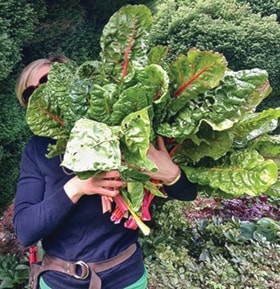Just when you thought it was over, it’s time to start again.
Not exactly a tantalizing lead, that sentence. I apologize. It’s roasting outside and I’m in the house with nary a breeze, hunkered over my computer, trying to think into the future, out beyond the prolific zucchinis and mildewed petunias, to autumn’s glowering skies and and fall days.
I’m not telescoping for fun, to alleviate the strain of these arid days. No, I’m solely taking you to October because I want you to think about Thanksgiving dinner and all the homegrown wonders you might serve: kale, arugula, swiss chard, lettuce, chervil, parsley, chives,Japanese turnips, escarole, mustard greens, Asian greens… Now doesn’t that list alone make you feel refreshed?
I start my winter salad garden in August and keep planting into September. Temperatures will soon cool enough for germination and our maritime climate (traditionally), is absolutely ideal for cool season growing.
There’s a lot to rethinking the vegetable patch as year-round provider, so if you are keen and new to the scheme, I recommend the book Winter Gardening in the Pacific Northwest by Binda Colebrook or The Zero- Mile Diet by Victoria’s own Carolyn Herriot. The West Coast Seeds catalogue is also very helpful and can be picked up for free at garden shops and nurseries around town. Here are a few basics:
1. Cut your losses now and make room in your garden. Yank up the unhappy annuals, compost the blooming lettuces, the fiery arugula, mangy nasturtiums and whatever else you have left. Their real estate is valuable.
2. Increase the productivity of your plot by amending the soil. Don’t even think of planting into spent earth. Crack your pitchfork into the hard ground, amend the soil with whatever compost you have, and use a balanced organic granular fertilizer which will release over time. I use a blend from Borden Mercantile (off McKenzie) which is affordable and understandable, meaning I can imagine eating what’s in it (kelp, canola, soya, alfalfa meal, etc.). I also use glacial rock dust for micronutrients but I’m a heavy grower and demand a lot from my salad beds, turning them over three times a year; usually in March, June and August.
3. Water deeply. Wake up the worms.
4. Let the soil rest for a few days or longer if you can bear it.
5. Sow seeds or use transplants available from farmer’s markets and garden centres.
6. Establish your plants. If you plan to be gone for Labour Day, have someone water during your absence.
With winter salad gardens, time is of the essence; you can’t dally. Winter greens need to be started before it’s too cold (and too dark) for them to put on much growth. We’re losing minutes a day at this time of year and that loss is felt by the plant. In a future column,
I’ll discuss the winter crucifers (broccoli, cauliflower, etc.) which are slightly more demanding, but if you can’t resist tucking a few of these giants in between your lettuces, go ahead. Their thick leaves are frost resistant and can offer some protection to the more tender plants.
